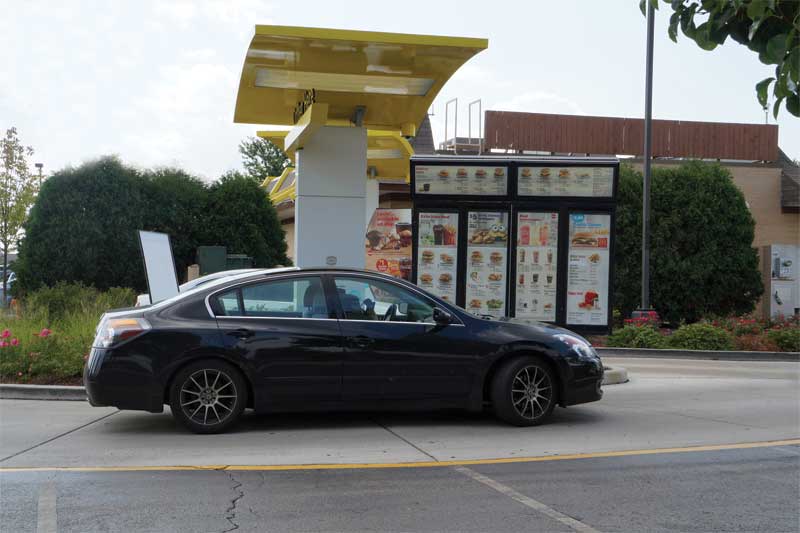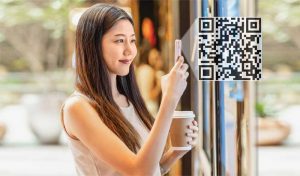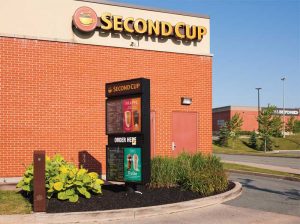Transforming the customer experience in quick-service restaurants with digital signage
by | 27 May 2020 10:24 am
 [1]
[1]Studies show digital menus move drive-thru customers along faster. The vivid images on a screen help people choose and place their orders more quickly.
By Sonia Yooshing
One of the fastest-growing markets for digital signage is the quick-service restaurant (QSR) industry, where customer-facing dynamic menus, touch-screen kiosks, drive-thru boards, window displays, and infotainment screens can all communicate with back-office software for managing inventory, finances, scheduling, and labour, so as to enable on-the-fly updates and richer data collection.
Not since the computerized point-of-sale (POS) system started replacing the cash register in the 1970s has there been a significant change in how orders are taken, processed, and served.
Indoor displays
One of the advantages of digital signage is the technology’s ability to unify a QSR’s in-store graphics through a single platform, for more seamless operations. High-definition liquid crystal displays (LCDs) have proven ideal for a range of digital menu boards and infotainment screens.
 [2]
[2]Touch-screen kiosks, such as those in McDonald’s Canada restaurants, require an intuitive graphical user interface (GUI) to enable customers to browse through product categories and options for customizing their meals.
The benefit of linking digital menu boards to POS systems is the opportunity to update the displayed food items throughout the day for different mealtimes and to remove or minimize them when there are shortages. Besides, they are also a great way to promote limited-time offers.
Studies show items promoted on indoor digital menu boards experience an average sales lift of three to five per cent.
Another digital signage technology that can prove useful is projection, which can work with special films to transform a QSR’s windows into dynamic screens, visible from outside. For this type of application, a digital projector—usually ceiling-mounted—throws the images onto an ultra-thin, semi-transparent window film.
Some shop windows even integrate a high-contrast light-control film between two sheets of glass, which changes to rear-projection screen mode with the application of voltage. Multiple adjacent windows can form a video wall.
 [3]
[3]Another option for serving dine-in customers is to place interactive digital menus right at their tables by using tablet touch screens.
Drive-thru screens
Outdoors, meanwhile, drive-thru communications systems can integrate high-brightness digital signage—adequately ruggedized to resist weather damage and vandalism—with order processing and POS systems. This way, promotions can be modified in real time and errors reduced while customers are in audio contact with QSR employees.
Also, studies show digital menus move drive-thru customers along faster. The vivid images on a screen help people choose and place their orders more quickly.
This speed is imperative, particularly for QSRs where 60 to 70 per cent of their business takes place at a drive-thru window where only one customer can be served at a time.
Ordering kiosks
Touch-screen kiosks, such as those in McDonald’s Canada restaurants, require an intuitive graphical user interface (GUI) to enable customers to browse through product categories and options for customizing their meals. After finalizing their orders on-screen, McDonald’s customers can pay at the kiosk and then proceed to the counter for takeout or to a table for dining in.
By interfacing with the POS system, the kiosks only display what is in stock and can indicate when an item is not. The use of food images helps break down language barriers, allowing many people to order more easily than they could in-person at the cash counter. Studies also show customers tend to place bigger orders when using touch screens than when ordering from a cashier.
 [4]
[4]Quick Response (QR) codes provide an opportunity to follow up on a digital sign’s ‘call to action.’
Again, dayparting enables the menus to be adjusted as needed. When McDonald’s Canada introduced all-day breakfast selections, for example, the kiosks made it easier to dictate which of the morning menu’s items would still be made available throughout the afternoon and evening (e.g. hash browns) and which would not (e.g. pancakes).
Similar kiosks can also be seen at Subway outlets as well as an increasing number of coffee chains. Many restaurants have implemented touch-screen ordering at their drive-thrus, too.
Table-mounted screens
Another option for serving dine-in customers is to place interactive digital menus right at their tables by using tablet-sized touch screens.
For example, at Toronto’s Pearson International Airport table-mounted tablets allow departing passengers to place food and drink orders while also checking their flight status.
The interactive dining table with an embedded display, where the entire surface is an ordering screen, such as the Surface Hub multi-touch coffee tables that were introduced by Microsoft 10 years ago, later rebranded as PixelSense and was eventually discontinued. That technology may have been ahead of its time. Today’s younger customers actively want this kind of interactivity, along with games to entertain them while they wait for their food. And with super-directional speakers, the audio component of digital signage content at one table need not be heard at the next table over.
 [5]
[5]Drive-thru communications systems can integrate high-brightness digital signage—adequately ruggedized to resist weather damage and vandalism—with order processing and point-of-sale (POS) systems.
Signal transmission
Beyond touch screens, there are other forms of interactive digital signage mediums. LinkRay technology, by way of example, uses the light-emitting diodes (LEDs) in backlit LCDs to emit special identification (ID) signals. The LEDs flicker on and off at a speed that cannot be detected by the human eye, but can be detected by smartphones’ camera sensors, similar to the scanning of Quick Response (QR) codes.
The signals transmitted in this way, which are tied to the digital signage content, allow a smartphone to access the LinkRay app and call up relevant product details, coupons, or other promotional information.
As LEDs are small, this technology can be integrated into everything from drive-thru menu boards to tabletop displays and the content that appears on the phone is based on the user’s language settings.
For QSRs, this functionality provides an opportunity to follow up on their digital signage’s ‘call to action’ with incentives for purchases, to facilitate online ordering and to expand their customer relationship management (CRM) efforts.
It enables businesses to deliver useful information to consumers when they want it and to gain insight into their level of engagement.
The connected restaurant
In these ways, digital signage has become part of an overall ongoing trend, whereby QSRs are deploying data-driven technologies to provide a more personalized customer experience (CX). Other examples include mobile apps that allow users to order beforehand and then pick up their food when they arrive.
In the near future, computer vision may join the mix to recognize customers’ faces or, at the drive-thru, their licence plates, then ask if they would like to place their usual order, as is already standard practice with online and phone orders for pizza delivery.
- [Image]: https://www.signmedia.ca/wp-content/uploads/2020/05/bigstock-135863069.jpg
- [Image]: https://www.signmedia.ca/wp-content/uploads/2020/05/McDonald’s-Canada.jpg
- [Image]: https://www.signmedia.ca/wp-content/uploads/2020/05/Crabby-Joe’s.jpg
- [Image]: https://www.signmedia.ca/wp-content/uploads/2020/05/bigstock-Asian-Young-Woman-Hand-Using-S-350928233.jpg
- [Image]: https://www.signmedia.ca/wp-content/uploads/2020/05/bigstock-138806093.jpg
Source URL: https://www.signmedia.ca/transforming-the-customer-experience-in-quick-service-restaurants-with-digital-signage/